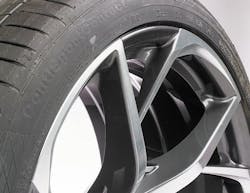Original equipment makers continue to make it riskier and riskier to change a tire without damaging wheels or tires.
In recent years, technicians have overcome challenges related to servicing alloy wheels, low-profile tires, run-flats and clad wheels. Now a new twist to servicing wheels and tires is on the horizon. Black wheels and raised spokes will be showing up in retail tire stores in a matter of months.
“In my mind the biggest challenge facing a full line tire dealer right now is the style elements of new wheels, especially black wheels,” says Pete Liebetreu, senior product manager at Hunter Engineering Co. “Folks have been operating in more of a traditional equipment kind of realm and these wheels and tires are presenting challenges.”
Liebetreu expects the new wheel styles will start showing up in dealers’ tire stores in one to two years, depending on the mileage habits of their owners. “One year might be the short window, but in two years I would expect tire dealers to start seeing these in decent volumes. The black wheels will just swamp them. The raised spokes are rarer but certainly harder to deal with.”
The good news is that with the right equipment and adapters, dealers can successfully service the latest wheel styles. MTD asked wheel equipment manufacturers what dealers can do to prepare for the challenges ahead. The two respondents were Liebetreu from Hunter Engineering and Nick McCullough, president of Rav America, the North American division of Ravaglioli SpA, which was acquired by Dover Corp. in October 2016. Need more care
“These new wheel styles continue a trend of ever more care and precision being required to mount and balance tires. Alloy wheels and low-profile tires have been the challenges of the last 20 years. Black open spoke designs are now the challenges of the future,” says Liebetreu.
Liebetreu says internally clamping black wheels, especially black wheels with open spokes, on tabletop tire changers will damage the wheels. “Those teeth on those tire changers will break through that paint and leave very visible marks, especially so on black wheels. For mounting you need to make sure you never internally clamp or the ‘bite marks’ will show. Center clamp changers eliminate this risk.”
A mount head that gives lots of clearance above the rim to clear the new raised spokes is also necessary. “Most heads designed years ago don’t give you enough clearance, meaning the head can contact the raised spokes,” says Liebetreu.
The open spoke design has been a factor in driving people away from the traditional tabletop tire changer to some of the newer center clamping designs.
“Tabletops are still really popular but the move to center clamping is driven by dealers deciding I’m not even going to take a risk that my technician, who may be new, or doesn’t know about these things, is going to internally clamp and damage a wheel that I will have to pay for,” says Liebetreu.
He says the raised spokes, while not very common, are on cars like the Maxima and the Rav4. “Typically when you are mounting a tire you bring the mount/demount head right to the rim edge and then the tire changer’s mount head will kind of back away a little bit. But now you can’t bring that mount head to the rim edge because if you rotate it you might hit that spoke. You have to set the mount head to the spoke height.”If techs lower the head to the usual place on the rim, the raised spokes scrape all the way across the mount head, potentially taking paint off the wheel and damaging the mount head and the wheel.
“This is an aftermarket trend that we’ve seen for a little while so a lot of our higher end tire changers have the ability to handle these raised spokes,” says Liebetreu. “Even our most basic mount heads have the capability to be set quite high so you can clear any of these spoke designs. Almost every Hunter model can have a version of an upgraded head put on it to handle these wheels.”
Wheel designs create issues
The cheapest way for a vehicle manufacturer to make a positive impact on the appearance of a vehicle is by redesigning the tire and wheel, according to McCullough. Larger diameter rims create a dramatic improvement in overall appearance. Paint schemes give the vehicle a sporting or luxurious look. However, the designs create challenges for tire technicians.
“Larger diameter rims simply add more difficulty to the mounting and balancing process. Wheels with special paint schemes add more risk to the process due to the fact that it is fairly easy to induce cosmetic damages during mounting and demounting. Raised spokes can create a dramatic effect, but certainly make mounting and balancing a more difficult task.”
Clad wheels are popular because they can create a desired appearance at a lower cost. “It is less expensive to cover the steel wheel with an attractive cover than it is to cast an alloy wheel,” says McCullough. “The clad wheels, however, pose their own set of difficulties and risks during the mounting and balancing process.”Tire technicians are also expected to correct for ride quality issues created by low-profile tires. “The low-profile tire simply looks better than a normal profile tire and allows the tire to fit comfortably within the fender well,” says McCullough. “The lower profile tire has better performance and handling characteristics as well. However, low-profile tires have compromised the ride quality of the vehicle and made precision wheel balancing even more critical.”
Not just for high-end shops
What should tire dealers who are shopping for equipment look for in order to service the new wheel styles? If they are not buying new equipment, what kind of accessories do they need for their current equipment?
“For mounting, look at some of the advanced tire changer options out there,” says Liebetreu. “They are not just for ‘high-end’ shops anymore because high-end challenges are found in mid-range vehicles. If you have older equipment, Hunter offers mount head upgrades that can handle these new designs for most all the changers it has offered for years.”
McCullough advises investing in a top-range tire changing system that offers no-lever function to have the most effective, efficient, and risk-free mounting operations possible. “These machines feature plastic to rim and plastic to tire contact. If improperly used these machines are designed so that the plastic tooling used by the machine may be damaged but the tire and rim will not be damaged.” He says the RavG1130.50 Magic and the RavG8945.26 Memory are cutting-edge tire changing systems with all-plastic contact. For balancing, Liebetreu suggests an easy-to-use balancer that minimizes the weights applied so they can’t be seen. “Silver weights look really bad on black wheels and dealers can’t always have black weights in stock.” He encourages dealers to look at balancers with Hunter’s SmartWeight technology, especially for solving appearance issues created when stick-on weights are placed on black, open-spoke wheels.
Liebetreu says shops also need an easy-to-use spoke mode that hides weights behind the spokes whenever possible. “These balancers are so smart at where they put the weights. It just pays off in every operation. Especially with flangeless, open spoke, high style and tape weight applications. It’s just too specialized now to trust your work to an old dynamic balancer,” says Liebetreu.
If a dealer is not ready to upgrade to new equipment, Liebetreu advises getting his or her technicians well versed on their balancer’s mode of hiding weights and splitting spokes. “This may be difficult because these were often ‘specialty’ features on older equipment and not designed to be used every day, so they are a little slow and clunky.”
Use correct adapters
McCullough says stiffer, better performing suspensions along with more rigid, low-profile tires have combined to make precision wheel balancing an absolute must. Wheel balancing must be spot-on or the risk of a vibration issue is high.
“Fifteen years ago leading manufacturers introduced balancing machines that touted their ability to measure the eccentricity of the tire and approximately measure the eccentricity of the wheel then guide the operator to turn or index the tire on the rim so that the assembly is as round as it is possible to make it. That process had its place 15 years ago when out-of-round tires and even rims were more prevalent.”
McCullough recommends buying a balancing machine with fewer bells and whistles and investing in precision adapters instead. He says the focus should be on using the correct mounting adaptors so that the mounting process used on the balancer closely replicates the process used on the vehicle.
“This means that instead of typical tapered ‘one size fits all’ cones you should use centering discs that precisely fit the center hole of the wheel. This is how the wheel is centered when installed on the vehicle. Lug-type adapters should be used in conjunction with the centering discs so that the rim is also centered and secured through the lug holes. This system is also used when the wheel is installed on the vehicle. These precision adaptor kits work well with most balancing machines.” ■
About the Author

Ann Neal
Ann Neal is a former senior editor at Modern Tire Dealer.
